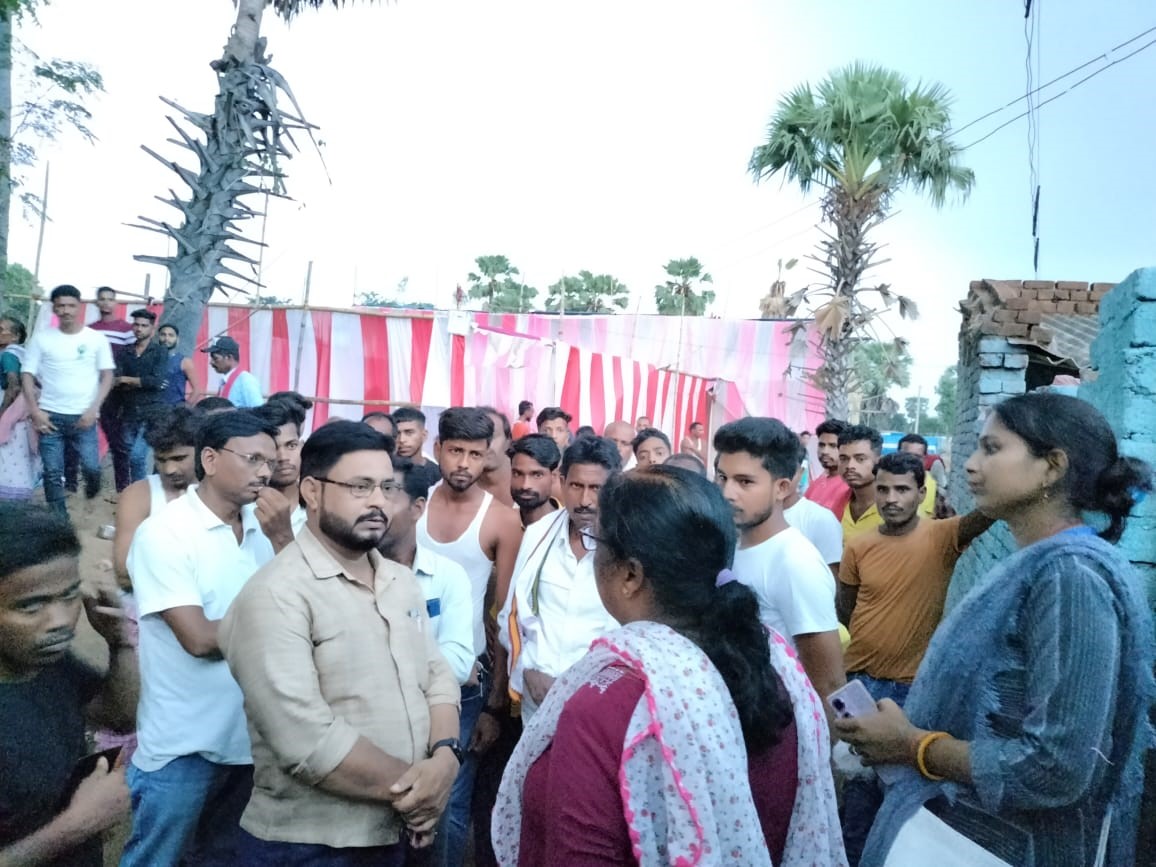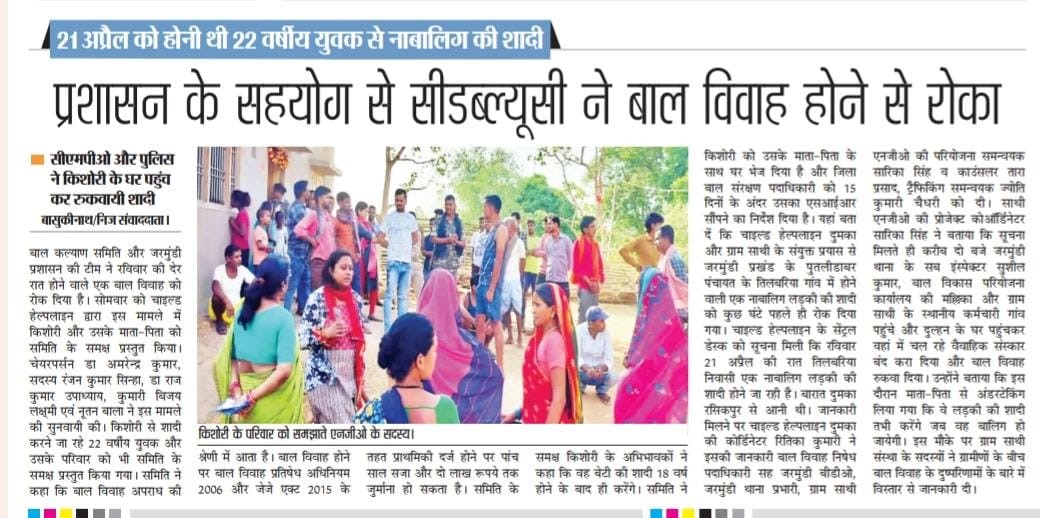Introduction
Child marriage remains a significant challenge in many rural parts of India, including Jharkhand.
This case study documents a successful intervention in Tilwariya, Dumka, where a 13-year-old girl was being forced into marriage. The collaboration between local authorities, police, the Child Welfare Committee (CWC), and Gram Sathi played a crucial role in preventing this unlawful and harmful practice.
Background
On April 21, 2024, Gram Sathi received an urgent communication from the Child Welfare Committee (CWC) regarding a child marriage scheduled for the next day in Tilwariya, PO-Bishanpur, PS-Jarmundi, Dumka. The 13-year-old girl was set to be married to a 22-year-old man from Rasikpur, PO-Rasikpur, PS-Town Dumka. The marriage was in direct violation of the Prohibition of Child Marriage Act, 2006, which prohibits the marriage of girls under 18.
Stakeholders Involved
Gram Sathi:
- Project Coordinator
- Program Manager
- Counselor
Local Authorities:
- Block Development Officer (BDO)
- Lady Supervisor
Law Enforcement:
- Tilwariya Police Station (In-charge, 2 Female Police Constables, 3 Guards)
- Child Welfare Committee (CWC)
Timeline of Events
April 21, 2024 - Pre-Intervention:
- The CWC issued a letter to Gram Sathi, alerting them to the scheduled child marriage.
- Gram Sathi’s team immediately contacted the BDO, who promptly issued an official order to halt the marriage.
- The BDO coordinated with the Tilwariya Police Station, ensuring their full cooperation.
April 22, 2024 - Day of the Scheduled Marriage:
- Early in the morning, Gram Sathi’s team, accompanied by the Tilwariya Police, reached the girl’s house in Tilwariya. However, upon arrival, they discovered that the girl and her family, forewarned of the intervention, had already fled.
- The police and Gram Sathi team initiated a thorough search in the surrounding areas, but the girl and her immediate family were not immediately located.
Afternoon of April 22, 2024:
- Despite facing resistance from the community, the team persisted in their efforts. They identified two uncles of the girl who were uncooperative and refused to reveal her whereabouts.
- The situation escalated, and the police had to detain the uncles for questioning. With the help of the village head (Gram Pradhan), the girl was eventually found hiding in a relative’s house.
Challenges Faced
- Community Resistance: The intervention faced significant resistance from the girl’s extended family and the community, who were initially uncooperative and tried to hide the girl to proceed with the marriage.
- Deceptive Statements: The girl, under pressure from her family, initially claimed that she was voluntarily entering a love marriage. This added complexity to the intervention, as the team had to carefully counsel her to understand the truth.
- Psychological Barriers: The girl’s emotional state was fragile. She expressed suicidal thoughts if the marriage did not happen, making the intervention more delicate.
Solutions Implemented
Collaborative Efforts:
The BDO’s swift action in issuing orders and the cooperation from the Tilwariya Police were pivotal. The police team included 2 female constables who played a crucial role in comforting the girl during the intervention.
The presence of Gram Sathi’s Project Coordinator, Program Manager, and Counsellor ensured that the girl received immediate psychological support.
Community Engagement:
The involvement of the Gram Pradhan was critical in locating the girl. His influence within the community helped ease tensions and facilitated the girl’s recovery.
Counselling and Legal Measures:
Upon finding the girl, the police and Gram Sathi team conducted extensive counselling at the police station. It was revealed that the girl had never experienced menstruation and lacked basic knowledge about marriage and reproductive health. This indicated that she was being coerced.
After prolonged discussions, the girl admitted that she was under family pressure and not willingly entering the marriage.
Key Learnings and Best Practices
Timely Intervention:
The quick response from all stakeholders was crucial in preventing the marriage. Immediate action can save lives and prevent long-term harm.
Effective Collaboration:
The case highlighted the importance of collaboration between NGOs, local authorities, law enforcement, and community leaders in addressing sensitive issues like child marriage.
Comprehensive Counseling:
Counseling played a vital role in helping the girl realize her rights and the dangers of early marriage. This was a key factor in her decision to reject the marriage.
Legal Enforcement and Education:
Legal agreements signed at the police station ensured that the families understood the consequences of violating the law. Educating both the girl and her family about the legal and social implications of child marriage was essential for a sustainable solution.
Outcome of the Intervention
The intervention led to several positive and impactful outcomes for the 15-year-old girl and her community:
Prevention of Child Marriage:
The immediate and effective action taken by Gram Sathi, in collaboration with the local authorities and police, successfully prevented the illegal child marriage. This not only protected the girl from potential physical and psychological harm but also reinforced the legal framework against child marriage in the community.
Reintegration into Education:
The girl was enrolled in a Kasturba Gandhi Balika Vidyalaya (KGBV), ensuring that she could continue her education in a safe and supportive environment. This step was crucial in securing her future and breaking the cycle of poverty and vulnerability often perpetuated by child marriage.
Increased Awareness and Legal Compliance:
The intervention raised awareness among the community about the legal implications and dangers of child marriage. The legal agreement signed by both families served as a deterrent, ensuring that they complied with the law. This not only safeguarded the girl but also set a precedent within the community, likely preventing similar incidents in the future.
Support through Government Schemes:
The girl was linked to the Savitribai Phule Yojana, a scheme designed to support the education of girls from marginalized communities. This provided her with additional financial and educational resources, further ensuring her ability to pursue her studies without the pressure of early marriage.
Empowerment and Well-Being:
Through counselling and continuous support, the girl was empowered to make informed decisions about her life. She was able to understand her rights and the importance of education, leading to a significant improvement in her psychological well-being and overall happiness.
Strengthened Community Relationships:
The case strengthened the relationship between the community, local authorities, and Gram Sathi. The successful collaboration demonstrated the effectiveness of collective action in addressing sensitive social issues, fostering trust and cooperation for future interventions.
Capacity Building for Stakeholders:
The involvement of the BDO, police, and CWC in this case enhanced their capacity to deal with similar situations in the future. The experience provided valuable lessons in coordination, community engagement, and legal enforcement, which can be applied in other contexts.
Long-Term Impact
This intervention not only changed the life of the girl involved but also had a broader impact on the community. It reinforced the importance of education over early marriage, empowered local leaders to take a stand against harmful practices, and set a legal and social precedent that will likely prevent other cases of child marriage in the area. The girl’s continued education and improved well-being are a testament to the success of this multi-stakeholder approach.
Conclusion
This case exemplifies how coordinated efforts between various stakeholders can effectively prevent child marriage and protect the rights of vulnerable children. The intervention not only prevented an illegal act but also ensured the girl’s continued education and well-being. Today, the girl is happily attending school and is no longer under the threat of forced marriage, thanks to the persistent efforts of the Gram Sathi team, the local authorities, and the CWC.



